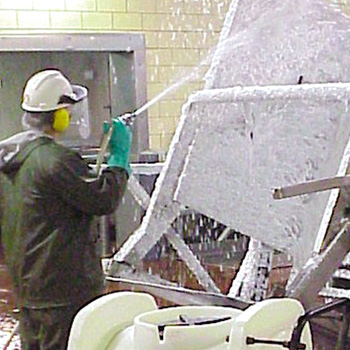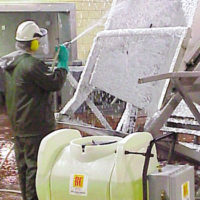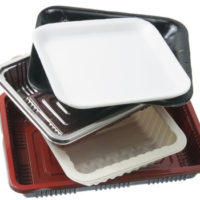Get the Most from Your Sanitation Chemicals

The effective use of chemical washes and antimicrobials is decidedly one of the most important aspects of the sanitation program in a food plant. Selecting the appropriate cleaning and sanitizing agents from the outset helps to ensure their effective use in the sanitarian’s battle against soils, biofilms and foodborne illness causing pathogens like Listeria monocytogenes and E. coli O157:H7.
“Microorganisms require nutrients to grow and food soils remaining on the equipment or in the production environment after processing provides unwanted bacteria to those nutrients,” says Terry McAninch, V.P., Research & Development with Birko Corp., a leading specialty chemical manufacturer that provides a product line of more than 200 cleaning and sanitizing chemicals and application equipment to the meat, poultry, microbrewery and food industries. “The first step is to effectively clean these food sources away, which will address 90% of the problem. Then, the purpose of the second step, applying the antimicrobial, is to kill any organisms remaining on the food-contact surface. If you take the food source away, the bugs can’t live.”
Chemical washes used for cleaning are primarily neutral, acid- or alkaline-based formulations. Choosing the right cleaner for the job means using the right cleaning mechanism, McAninch adds. For example, the basic cleaning mechanism hydrolysis literally breaks the soil molecules apart and washes away these fine pieces via rinsing. “Hydrolysis is effective in meat processing environments where soils require this kind of breakdown,” he says. “Strong alkaline cleaners are typically used as part of hydrolysis.”
“However, in plants with aluminum equipment, the processor should look for cleaners with displacement properties,” McAninch states. “Displacement is a cleaning mechanism that lifts soils off of a surface as a result of applying the cleaner between the soil and the surface you are cleaning. There are several different ways you can do this, such as applying an oxidizing type cleaner or a cationic-based cleaner.”
A third cleaning mechanism is dissolution, recommended for situations in which hard water salts build up on plant food-contact surfaces. The method involves applying an acid-based cleaning solution to a hard water scale that dissolves soils into the liquid media and allows it to be flushed out of the system as part of the cleaner itself. Dissolution is also an effective cleaning method when the plant is trying to remove machine grease or oils, as long as a solvent-based cleaner is used.
“Neutral cleaners are good for general soil removal, or hand scrubbing type applications where you’re wiping down counters and mopping floors,” he adds. “These are good in any scenario where you need a good spectrum of cleaning ability without the chemical presenting a hazard to people using the product.”
The Antimicrobial Arsenal
Although efficient cleaning will remove most of the bacteria, the application of an antimicrobial agent is essential to remove any residual bacteria. However, McAninch cautions, because microorganisms have an ability to adapt to sanitizers, sanitarians must not only select appropriate chemicals for their operations but also be prepared to select more than one. “A good sanitation program needs to be variable so that bacteria don’t get a chance to immunize themselves from the system or chemicals that you’re using. You do that by changing the antimicrobials periodically because it will eliminate some bacteria that have developed a tolerance to a particular sanitizer.”
“Knowing when to do an actual change-up with the sanitation chemicals you’re using can be a challenge,” he says. “Typically, when verification tests show that bacteria numbers are starting to climb—even though you’ve been using the same cleaning and sanitizing regime day in and day out—it’s a good indication that you need to do something different.”
In addition to traditional antimicrobials—chlorine bleach, quaternary ammonium chlorides and iodophors—chlorine dioxide and peracetic acid have gained currency as complementary disinfecting agents in the food plant, precisely because food processors are looking for something different to add to the sanitation mix to disrupt microorganisms. McAninch recommends that food processors consider the strengths and weaknesses of each of these antimicrobials in terms of their specific plant application needs to find the most effective mix:
• Chlorine Bleach. Widely used in food plants, it is the most economical and provides an immediate kill. It does not give long-term residual protection, and is corrosive with a pungent odor.
• Quaternary Ammonium Chlorides. Considered safest for use on equipment, quats provide excellent residual kill over time. These can be allergenic to some staff, however, and are not good for use on spore-forming bacteria or fungi such as molds and yeasts.
• Iodophors. These substances also present residual protection and work well even when soil remains on a surface. If grossly overused, it is corrosive and can stain plastic surfaces.
• Peracetic Acid. This is the best anti-microbial to use if a surface is not clean, such as drain areas where biofilms lurk, and it provides the best immediate kill. It has a pungent odor in its concentrated form, and can be corrosive if grossly overused.
• Chlorine Dioxide. This compound has the ability to penetrate biofilms and inhibit their formation and growth. It gives an immediate kill but no long-term residual protection.
“There are many other factors that can help you select the right antimicrobials and chemical washes,” says McAninch, “but it is important to work with your sanitation chemical supplier to determine what is available that will be most effective for your operation.”
www.birko.com
Looking for a reprint of this article?
From high-res PDFs to custom plaques, order your copy today!








